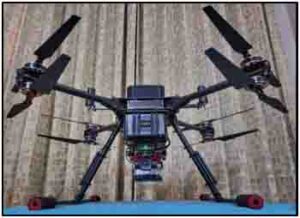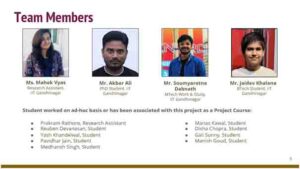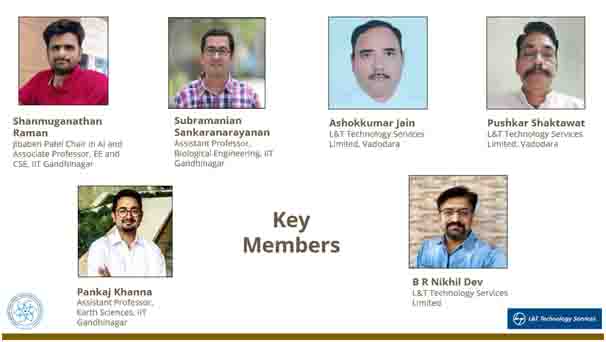- With 24% of India’s cotton area and 37% of the total output, it’s no wonder Gujarat is the leader in cotton cultivation
- This massive endeavour has been made possible thanks to the generous support of L&T Technology Services Limited, Vadodara, and the brilliant minds at IIT Gandhinagar
- Combining AI with drone technology in cotton farming paves the way for a future where agriculture is as intelligent as it is sustainable: Prof. Subramanian Sankaranarayanan
NE AGRICULTURE BUREAU
GANDHINAGAR, SEPT 7
Aree Gujarat, our cotton farmers are the real MVPs! Contributing a whopping 35% to India’s cotton production, Gujarat’s khetis are a huge deal, bhai. With 24% of India’s cotton area and 37% of the total output, it’s no wonder Gujarat is the leader in cotton cultivation, with about 26.82 lakh hectares of cotton being farmed every year. (Data credits to Gujarat Agricultural Department).

But now, the game is changing, and IIT Gandhinagar is at the forefront of this revolution. We’ve embarked on a groundbreaking project that’s all set to take cotton farming to the next level, leveraging cutting-edge tech like drones (UAVs), computer vision, and image processing. The main aim? To make cotton farming smarter, more efficient, and profitable for our hardworking kisans. This project, spearheaded by IIT Gandhinagar, is all about creating a comprehensive smart farming platform that provides farmers with real-time insights and tools to monitor, manage, and optimise their cotton crops. And guess what? We’ve even built a detailed dataset of cotton cultivation images, captured through drones and close-up DSLR shots, which aids in everything from crop detection and segmentation to identifying crop stress. Ultimately, this project is not just about promoting sustainable agriculture but also giving a solid boost to India’s agricultural economy.

This massive endeavour has been made possible thanks to the generous support of L&T Technology Services Limited, Vadodara, and the brilliant minds at IIT Gandhinagar. Our dedicated team includes Prof. Shanmuganathan Raman, Associate Professor, EE and CSE, Prof. Pankaj Khanna, Assistant Professor, Earth Sciences, and Prof. Subramanian Sankaranarayanan, Assistant Professor, Biological Engineering, Mahek Vyas, Research Assistant, Soumyaratna Debnath, MTech Work & Study, Akbar Ali, PhD Student, Jaidev Sanjay, Khalane BTech Student, Reuben Shibu Devanesan, Prakram Singh Rathore, worked tirelessly to bring this project to fruition. The project benefited immensely from the invaluable support and collaboration of the research team at L&T Technology Services, including Ashokkumar Jain, L&T Technology Services Limited, Vadodara; Pushkar Shaktawat, L&T Technology Services Limited, Vadodara, and Mr. Nikhil Dev, L&T Technology Services Limited. Additionally, the dedicated efforts of Medhansh Singh, Pavidhar Jain, Yash Khandelwal, and Harshvardhan Vala from IIT Gandhinagar for their meticulous work on annotating aerial images, which was crucial to the project’s success.

Professor Pankaj Khanna from IIT Gandhinagar shared his thoughts: “Drones are the new tools for real-time datasets, helping us understand crop-growth cycles better. Analysing these datasets with advanced techniques is the new frontier, and it’s only possible through interdisciplinary collaboration, which is the DNA of IIT Gandhinagar.”
The project is already delivering significant outcomes, particularly the development of a smart farming platform that utilises advanced aerial imagery and computer vision techniques. One standout feature is the Stressed Area Alert Generation system, which uses RGB aerial images and image classification models to detect stress in crops, enabling farmers to take swift action to maintain crop health. Another highlight is the crop density analysis, powered by next-generation algorithms like YOLO, Detection Transformers, and Segment Anything, which precisely detect and segment crops, assisting in effective weed management and ensuring healthier crops. Additionally, cotton bud detection has seen major improvements thanks to algorithms like Mean Shift and Region-growing, making it easier to detect cotton buds from aerial images, thereby supporting better yield predictions and efficient harvesting.
Professor Shanmuganathan Raman from IIT Gandhinagar added, “We’ve also explored advanced image enhancement techniques using Generative models to improve low-quality images. These technologies have been seamlessly integrated into a user-friendly, web-based app, bringing advanced monitoring and management tools directly to our farmers. This fusion of AI and image processing with agriculture is set to boost yields, reduce resource wastage, and promote sustainable farming practices.”
“Combining AI with drone technology in cotton farming paves the way for a future where agriculture is as intelligent as it is sustainable,” added Prof. Subramanian Sankaranarayanan.
The project also generated a valuable dataset of over 5,000 images captured via drones and DSLRs, documenting the entire life cycle of cotton crops across two self-grown cotton fields. This data is invaluable for researchers and agricultural experts, helping them develop advanced technical solutions for improving crop yields and managing stress, which are essential for sustainable cotton farming.
Looking ahead, the future of this project is even more promising. IIT Gandhinagar is planning to enhance multispectral imaging by incorporating additional spectral bands to capture a broader range of data. Multispectral imaging, which extends beyond the visible spectrum to include infrared and ultraviolet light, will allow for more detailed monitoring of crop health and early detection of stress and disease. This advancement will significantly improve the precision in assessing plant health and soil conditions, leading to more targeted interventions. The advanced application of multispectral imaging is expected to take precision agriculture to new heights, optimising crop management and boosting sustainability in farming.












